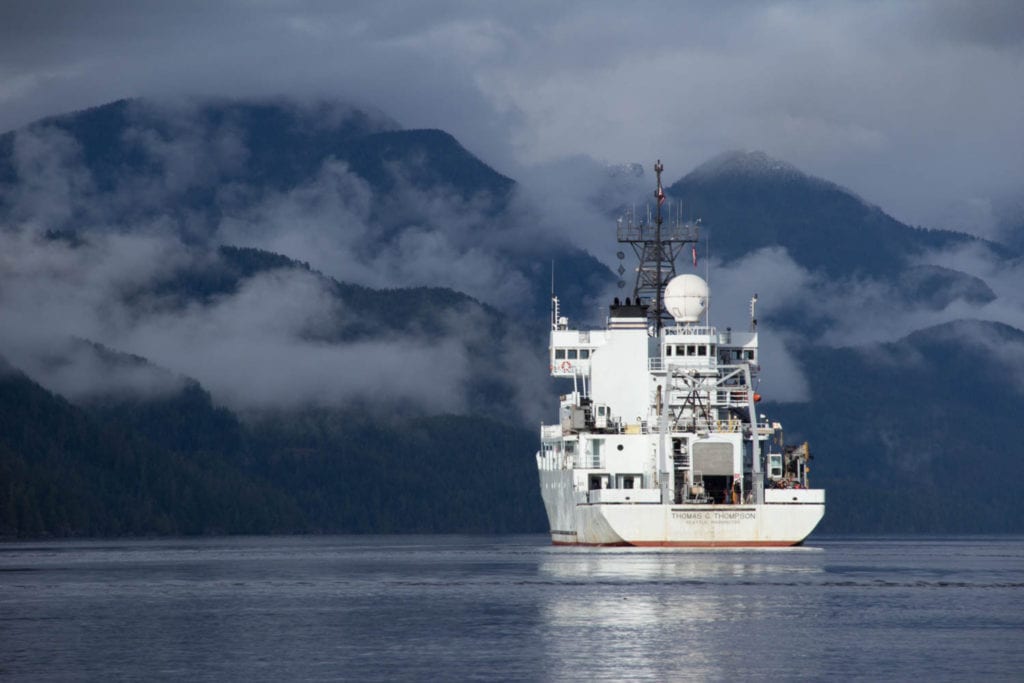
The Navy has completed refitting three of its oldest but largest oceanographic research ships (AGORs), permitting them to serve for an additional 15 years. The global-class ships, R/V Thomas G. Thompson (AGOR 23), R/V Roger Revelle (AGOR 24) and R/V Atlantis (AGOR 25), entered service between 1991 and 1998 and were built for a 30-year service life.
The final ship, Atlantis, will complete its overhaul on July 10. Rob Sparrock, program manager for research ships with the Office of Naval Research (ONR), said the Navy’s investment of $150 million for all three of the research ships was a good value. “We’ve extended their service lives by at least 15 years, so we got 45 years of service for less than the cost of one new ship with a 30-year service life.”
Sparrock manages six Navy-owned oceanographic research vessels; the historic deep-submersible vehicle Alvin; and the Floating Instrument Platform, or FLIP, which are charter-leased to U.S. academic research institutions to operate and maintain in support of Navy and U.S. ocean research objectives.
ONR also employs other oceanographic platforms, such as unmanned underwater vehicles and unmanned air vehicles, which are used to collect field data through the Naval Research Facilities program.
The Thomas G. Thompson was delivered to the Office of Naval Research on July 8, 1991 and is operated by the University of Washington. A permanent civilian crew is assigned to the ship, but various researchers deploy in support of their specific programs and are typically funded by the National Science Foundation, Navy, NOAA and other federal/state agencies.
Because her expected service life was 30 years, she would have been retired this year. Instead, Vigor Industrial shipyard in Seattle was contracted to renovate the ship, which began in June of 2016 at a cost of $52 million.
Sparrock said the ships were upgraded with new diesel engines, which are more reliable and environmentally friendly, as well as quieter, an important attribute in oceanographic research. The ships now have better laboratory and work spaces, along with improved habitability, new berthing spaces and a gym.
“They’re 25 to 30 years old, but we’ve made them ‘newer’ and greener than most research vessels,” he said.
During the refit, the propulsion system was largely replaced with new diesel generators, overhauled propulsion motors, and new switchboards, control systems and alarms. Electrical cable and pipework were replaced as well as the air conditioning, refrigeration, sewage and freshwater systems. New research and navigation instruments were also added.
The two newest Navy Ocean-class AGORs, R/V Neil Armstrong and R/V Sally Ride, are five and six years old, respectively. By conducting the service life extensions on the oldest on the Navy’s 15 research ships, Sparrock said the Navy’s ocean-going fleet is “good for another 10 to 15 years.”

The AGORs are operated by partner academic institutions. A fourth ship of the class, the NOAAS Ronald H. Brown, was built for and operated by the National Oceanic and Atmospheric Administration. All four ships were built at VT Halter Marine in Pascagoula, Mississippi.
While Atlantis can perform the same kinds of research as the other Globals, and will sometimes deploy without the deep submergence vessel, only Atlantis can support Alvin. They’re a pair. “Atlantis will perform 280 to 300 days of underway science a year, with 100-plus days devoted to Alvin work.” Sparrock said.
Atlantis is operated by Woods Hole Oceanographic Institution (WHOI), and is the mothership to the Navy’s deep-diving Alvin bathyscaph. Although Alvin first entered service in 1964, it has been systematically modernized and upgraded over the years to remain quite youthful, and has made more than 5,000 dives.
“She’s been rebuilt so often that it’s not a 60-year-old platform we’re refurbishing, said Sparrock. “Most recently, we upgraded her to have a 6,500-meter depth capability.”
Sparrock said Alvin is the last of the Navy’s deep ocean research submersibles, and has a long history of finding lost nuclear weapons, discovering previously unknown hydrothermal vents and associated sea life, and locating the Titanic. “It’s a fascinating tool of the Academic Research Fleet,” Sparrock said. “Alvin is a national treasure.”
In addition to the Global-class ships, there are also regional-class and local-class ships, which perform missions in coastal waters. The National Science Foundation and State Institutions also own ships in the Academic Research Fleet. Scheduling for the 18 vessels of the U.S. Academic Research Fleet is coordinated by the University-National Oceanographic Laboratory System (UNOLS), an organization representing 59 academic institutions and national laboratories that conduct in oceanographic research and work together to coordinate the oceanographic ship and research facility schedules.
NOAA’s Ronald H. Brown and the U.S. Coast Guard medium icebreaker USCGC Healy are not part of the academic research fleet per se, but participate in UNOLS scheduling.
- A Day to Remember - September 11, 2023
- Indo-Pacific Maritime Security Exchange will examine emerging capabilities and capacity - July 12, 2023
- Cold Waters Spark Warm Relationship - April 20, 2023






